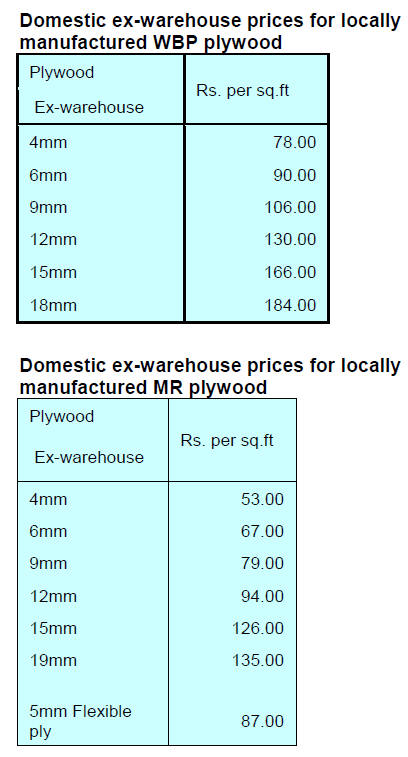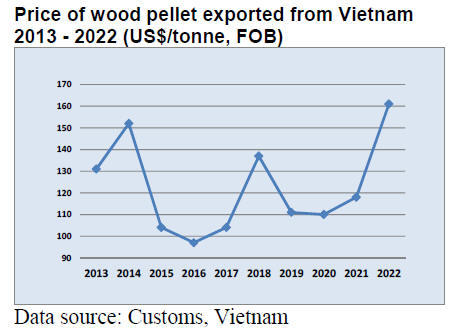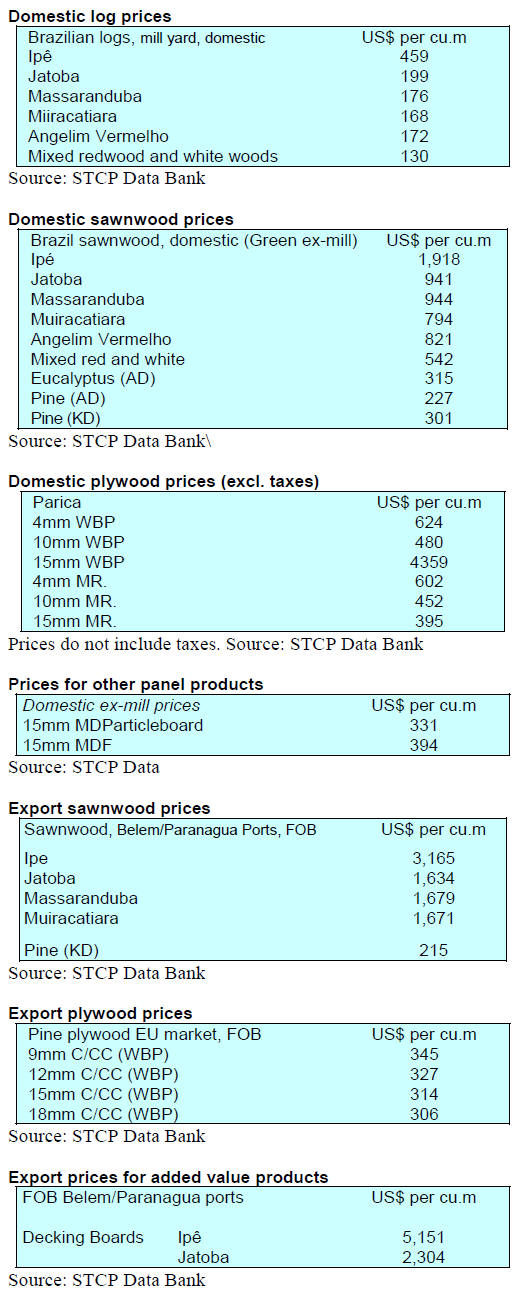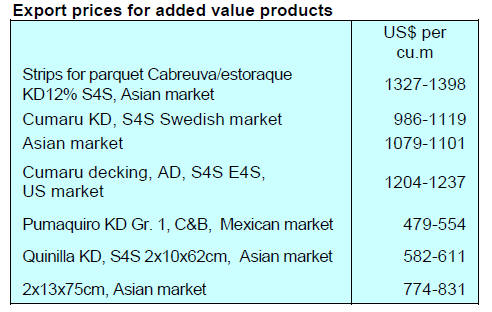4.
INDONESIA
Indonesian and UK companies agree
US$112 million
deal
A memorandum of understanding has been signed
between Indonesia and the UK for the purchase of wood
products worth US$112 million. The MoU is between ten
Indonesian companies and two British companies.
The Trade Minister said the British companies are
interested in paper and wood products. In 2022 wood
products were one of Indonesia's main export commodities
to the UK with a value of US$177.8 million. In the same
year Indonesian paper product exports to the UK
amounted to US$59.8 million.
See:
https://pressrelease.kontan.co.id/news/produk-kayu-kertasindonesia-diminati-inggris-mendag-saksikan-mou-usd-112-juta
Strengthening the VPA through Broader Market
Recognition (BMR)
Indonesia hosted a forum on increasing legal/sustainable
timber trade through a policy on Broader Market
Recognition (BMR). The aim is to encourage those
tropical timber producing countries which have, or plan to
negotiate, VPAs.
The Director General of Sustainable Forest Management
in the Ministry of Environment and Forestry Agus
Justianto, said Indonesia hopes that the FLEGT VPA will
be implemented consistently by parties to the agreement.
He added that producing countries need broader market
recognition of their national systems through a
partnerships based on trust, respect and mutual benefits.
See:
https://forestinsights.id/2023/03/01/indonesia-inisiasiforum-broader-market-recognition-bmr-perkuat-perdagangankayu-lestari/
No tolerance of irresponsible campaigns against
Indonesia's carbon governance
Indonesian Environment and Forestry Minister, Siti
Nurbaya, has vowed to fight against "irresponsible
campaigns" aimed at discrediting Indonesia's carbon
governance.
In a technical discussion on the role of Indonesia's carbon
markets in supporting overall mitigation in global
emissions the Minister reiterated that Indonesia has in
place legally sound carbon governance and warned against
attempts to undermine it by "systematic and irresponsible"
carbon market players.
She added that Indonesia's carbon governance was
designed to prevent double-counting practices. The
Minister also highlighted the fact that Indonesia's carbon
trading represents business opportunities worth billions of
dollars.
See:
https://foresthints.news/minister-no-tolerance-ofirresponsible-campaigns-against-indonesias-carbon-governance/
In related news the Minister announced the country is
prepared to offer results-based payments (RBP) to
interested buyers for its achievements in reducing
emissions from deforestation and forest degradation, as
well as enhancing forest stock carbon through REDD+
scheme from 2018 to 2020, resulting in a remarkable
reduction of over 577 million tonnes of CO2.
See:
https://foresthints.news/indonesia-announces-readiness-forsales-of-over-577-million-tonnes-of-co2e-from-rbp-scheme/
Carbon Trading, Financial Services Authority
prioritises domestic market
The Financial Services Authority (OJK) said carbon
trading is at an early stage and would give priority to the
domestic market.
This was determined after the Authority held discussions
with the Ministry of Environment and Forestry. "In the
first stage there will be restrictions on overseas
transactions, the priority is for domestic fulfillment first,
said the Chief Executive of the Supervision of Capital
Markets, Derivatives Finance and Carbon Exchange of the
Financial Services Authority.
See:
https://forestinsights.id/2023/03/04/ojk-soal-bursa-karbondahulukan-pasar-domestik-perdagangan-di-pasar-sekunder/
Government must be aggressive in conducting
reforestation
The World Resource Institute (WRI) said the government
must be aggressive in conducting reforestation in the
country. WRI Indonesia Programme Director, Arief
Wijaya, said Indonesia has a land area of 180 million
hectares with a composition of 95 million hectares of land
that still has forest but that around half is degraded.
During a discussion on Indonesia's 2023 Climate
Policy
Outlook Arief is quoted as saying "Currently, reforestation
is only around 3 to 5% of the annual deforestation rate and
reforestation must be accelerated.
See:
https://www.antaranews.com/berita/3410850/wripemerintah-mesti-agresif-melakukan-penghijauan-hutan-diindonesia

Through the eyes of industry
The latest GTI report lists the challenges identified by the
private sectors in Indonesia.
See:
https://www.ittoggsc.org/static/upload/file/20230214/1676340295137619.pdf
5.
MYANMAR
Economic prospects for 2023
According to the Asian Development Bank Myanmar’s
economy looks set to remain moribund this year with
forecasters predicting the country will see the region’s
lowest growth and highest inflation rate. Myanmar’s GDP
is expected to grow 2.6% this year, the lowest among
ASEAN countries, while inflation could be higher than
any other member of ASEAN.
Myanmar is struggling to revive a fragile economy by
promoting foreign investment. The country approved over
US$92 billion worth of foreign investment in 2022
according to the Directorate of Investment and Company
Administration.
See:
https://www.irrawaddy.com/business/economy/myanmarstough-economic-times-forecast-to-continue.html
Trade in Myanmar teak
Under a headline ‘Myanmar teak trade: Highly prized,
highly dodgy’ the Indian Express reports on conversations
with traders in Myanmar and India who say the conflict on
the ground in Myanmar and frequent changes to
regulations by the Myanmar authorities are challenging.
Since the February 2021 millitary take over in Myanmar
the junta took control of Myanma Timber Enterprises
(MTE), the state-owned company which has exclusive
rights over the country’s timber trade. The MTE has been
sanctioned by many countries.
Quoting a report from the International Consortium of
Investigative Journalists (ICIJ) the India Times says India
is the second largest importer of "conflict wood" from
Myanmar following China. The ICIJ investigation also
implicates importers in western countries.
According to Forest Watch Indian companies imported
over US$10 million worth of teak from Myanmar between
February 2021 and April 2022. The India Times points out
that “despite the controversy surrounding "conflict wood"
from Myanmar India has not banned the import of teak
wood from the country”.
See:
https://indianexpress.com/article/explained/explainedclimate/myanmar-teak-trade-highly-prized-highly-dodgy-8476232/
and
https://www.indiatimes.com/explainers/news/explained-whyteak-imported-from-myanmar-is-called-conflict-wood-595202.html
and
https://www.icij.org/investigations/deforestation-inc/myanmarteak-trade-sanctions-military-regime/
Export target
In fiscal 2022-2023 Myanmar's foreign trade target is
US$29.5 billion but more than US$1,949 million has been
received according to statistics released by the Ministry of
Economy and Commerce.
From April to March of fiscal 2022-2023 Myanmar's
foreign trade was US$15.5 billion from exports of
agricultural products, animal products, water products,
mining equipment, forest products and industrial goods.
A National Export Strategy is being implemented to
increase exports and the priority sectors are the
agricultural product-based food production sector; textile
and clothing sector; industrial and electrical
sector; Aquatic industry sector; forest products
sector; digital products and services sector; logistics
service sector; quality management sector; Trade
Information Services Sector and innovation and
entrepreneurship sector.
See:
https://news-eleven.com/article/245617
6.
INDIA
Pace of growth cools
India's domestic economy is the main drive of growth and
there was a slowdown in economic activity late last year.
The economy grew 13.2% in April-June quarter and 6.3%
between July and September but GDP growth slowed to
4.4% in the final quarter of 2022.
Rising interest rates have weakened domestic demand and
the weaker rupee has pushed up the cost of imports.
See: https://www.livemint.com/
Scaling up of current policies could help lower
emissions
India will be the fastest-growing economy among the
seven largest emerging markets and developing economies
according to the World Bank in its Global Economic
Prospects report and the pace of urbanisation will increase
driving demand for wood products.
According to the IMF India has made significant progress
towards meeting its emissions reductions targets under the
Paris Agreement but, with current policies, total GHG
emissions would nonetheless increase by more than 40%
by 2030.
While a modest increase in short-term emissions may be
necessary to meet poverty reduction and energy security
goals, a more rapid scaling up of current policies could
help lower emissions considerably over the medium-term
and bring India closer to a path to net zero by 2070.
See:
https://www.imf.org/en/News/Articles/2023/03/06/cf-indiacan-balance-curbing-emissions-and-economic-growth
Sharp rise in demand for decorative laminates
Plyrepoter has commented that 2022 saw a sharp rise in
demand for decorative laminates in India as well as in
international markets which has encouraged investment in
local laminate manufacturing capacity.
However, with some 300 laminate manufacturers in the
country and others about to become operational in 2023
will see changes in the market for laminates. Plyreporter
foresees intense competition in laminate sector which will
likely bring down margins.
See:
https://www.plyreporter.com/article/93399/the-laminatemarket-to-witness-intense-competition-in-2023-ply-reporterprediction-2023



7.
VIETNAM
Wood and wood product (W&WP)
trade highlights
Statistics provided by the General Department of
Customs reveal that in February 2023 W&WP exports
earned US$800 million, down 0.7% compared to January
2023 and down 11% compared to February 2022.
In particular, WP exports are estimated at US$490
million, down 0.3% compared to January 2023 and down
30% compared to February 2022.
In the first 2 months of 2023 W&WP exports earned
US$1.6 billion, down 35% over the same period in 2022.
In particular, WP exports stood at US$982 million, down
48% over the same period in 2022.
Vietnam's W&WP imports in February 2023 were
reported at US$150 million, up 25% over the previous
month. However, compared to February 2022 imports
fell by 21%.
In the first 2 months of 2023, W&WP imports have been
estimated at US$270 million, down 39% over the same
period in 2022.Vietnam's imports of logs and sawnwood
in February 2023 stood at 290,400 cu.m, worth US$109.2
million, up 24% in volume and 25% in value compared
to January 2023.
However, compared to February 2022, wood imports
decreased by 21% in volume and 19% in value.
In the first 2 months of 2023 imports of wood reached
466,900 cu.m worth US$175.4 million, down 41% in
volume and 41% in value over the same period in 2022.
Wood pellet exports in 2022
In 2022 Vietnam’s wood pellet exports increased
substantially, making Vietnam the second largest wood
pellet exporter after the US. The volume of exported
reached over 4.88 million tonnes, up 39% compared to
2021 while the value surged to US$787 million, 90% up
compared to 2021.
Pellet export prices soaring
The average price of wood pellets exported from Vietnam
in 2022 reached a 10 year record as price increased
continuously but showed signs of a slightly slower pace of
increase between June and September. However, the price
rebounded after that and reached the record of over
US$189/tonne in December 2022.

Japan and South Korea leading Vietnam’s wood
pellet
markets
Almost all wood pellets produced in Vietnam are exported
to Japan and South Korea. In 2022, the volume of wood
pellet exported to these two markets accounted for 98% of
the total export and 97% of Vietnam's total export turnover
in the year. Exports to Japan increased strongly compared
to 2021.
Forecast of wood pellet market in 2023
There are a number of factors that may impact the
production and trade of wood pellets in 2023. The first
factor is the global wood pellet supply and demand
situation. At present Vietnam represents the 2nd largest
supplier of wood pellets in the world (after the US) and
therefore the fluctuation in supply and demand of this
biomass fuel in the world will have a direct impact.
In 2023, the supply of Canadian and US wood pellets to
the EU market may expand after a recent period of
scarcity of sources due to the Russian invasion of
Ukrainian as well as the increased maritime freight rates.
In the first half of 2022 North American pellet
manufacturers redirected their supply flows from the
Japanese and Korean markets to the EU to capture the
much higher prices in the EU markets.
The sharp drop in supply from North America, thus,
forced Japanese and South Korean businesses to find
alternative sources. This created opportunities for
Vietnamese businesses to expand export markets.
Because of the instability in energy supplies the result of
the Russian aggression Japan and South Korea stockpiled
pellets. Up to now the wood pellet stock in these two
markets is at a high level. Against this backdrop
Vietnamese exporters will hardly have the opportunity to
expand their markets in these two markets in 2023.
The switch to biomass fuel in Japan and South Korea is
directly affecting prices of wood pellets from Vietnam.
Currently, the export price of wood pellets from Vietnam
is on a downward trend. Information from some
exporters shows that in the coming months, the export
price to Korea may drop down to US$125-135/tonne
FOB and to Japan down to US$150-160/tonne FOB. This
will lead to a very sharp reduction of wood pellet exports
from Vietnam.
Large stocks also allow Japanese consumers to tighten
standards for quality and sustainability requirements.
Certain Japanese traders are asking Vietnamese suppliers
to strictly follow environmental and quality requirements.
The power crisis in the EU in 2022 created an over
optimistic expectation of the market potential for
Vietnam's wood pellets.
Statistics from the General Department of Customs show
that by the end of 2022 Vietnam's wood pellet exports to
the EU stood at just US$15.2 million, equivalent to 1.9%
of the total exports.
The major reason behind this modest shipment of
Vietnamese wood pellets to the EU is the quality and
environmental standards that this market sets including
the sustainability certification that very few local wood
pellet businesses can meet.
The expanding export market in the first half of 2022 has
boosted investment in wood pellet production in
Vietnam. From the beginning of 2023 export prices have
been falling rapidly and this is likely to have a huge
negative impact especially for new or under construction
wood pellet plants.
In 2022 alone, about 70 new wood pellet factories were
built. Of these newly built factories about 20 are large,
using EU technology, while 50 factories are using
Vietnamese and Chinese technologies.
From the beginning of 2023 the export price of wood
pellets has been falling while the price of logs, mainly of
acacia planted by thousands of Vietnamese farmers, after
a period of "price fever", has also sharply decreased.
These fluctuations in wood pellet markets and production
may negatively impact the entire supply/value chain of
Vietnam’s wooden products. Vietnamese operators have
been urged to scrutinise their wood pellet business and to
reshape the industry.
Statistics provided by Vietnam General Department of Customs
and analysed by a Technical Group of Vietnam’s wood
associations with support from Forest Trends
8. BRAZIL
Engineered wood for Brazil’s
construction sector
A Woodlife Sweden International Exhibition, focusing on
engineered wood promoted by FIEP (Federation of
Industries of Paraná State) the Sweden Embassy and a
Swedish Institute was held in Curitiba, Paraná State.
Engineered wood products have definable mechanical
properties and can be manufactured from a variety of
timbers.
One of the advantages claimed of engineered wood
technology it is a material that helps develop a green
circular economy and that the construction processes are
shorter when engineered wood products are used.
Representatives from the Center for Timber Producers and
Exporters of Mato Grosso State (CIPEM) attended the
exhibition.
See:
https://cipem.org.br/noticias/cipem-marcara-presenca-emexposicao-internacional-com-foco-na-madeira-engenheirada/
http://www.madeiratotal.com.br/madeira-ganha-destaque-comoalternativa-sustentavel-em-sistemas-construtivos/
Mahogany plantations - revisited
Following a news item the last Market Report (Vol. 27
No. 4) on African mahogany plantations in Brazil a
representative of the Brazilian Association of African
Mahogany Producers provided the following additional
details:
“In Brazil today we have around 42,000 hectares planted
with Khaya Grandifoliola. About 23,000 hectares planted
with Khaya Senegalensis. About 800 hectares planted with
Khaya Anthotheca and about 500 hectares planted with
Khaya Ivorensis. These plantations are all over Brazil. The
states with the most plantations are Minas Gerais, Pará,
São Paulo, Roraima, Goiás, Espírito Santo, Mato Grosso,
Mato Grosso do Sul, Tocantins, Paraná and the block of
states in Northeastern Brazil.
There are already several producers carrying out thinning
in plantations that are already 11, 12 and 14 years old.
This thinned wood is being commercialised in the internal
market and with it we are already manufacturing chairs,
doors, decoration objects, wood for roofs, pergolas and
other utilities and the wood is being sold in its entirety
here in our Brazilian market.
There are plantations that are over 20 years old and are
ready for harvesting. These are Khaya Grandifoliola
plantations and the Association estimates the around 5,000
hectares ready for cutting in Pará. Small volumes of
African mahogany are exported to the Caribbean.
The Association is working to strengthen the image of
Khaya Grandifoliola outside Brazil. Within Brazil this
wood is already well known and there are already
creations by the best designers in Brazil”.
For more information see the Association presentation at:
https://www.youtube.com/watch?v=nbg_GZXNyps
Acre support for wooden flooring company
The Acre Business Agency (ANAC), an agency linked to
the state government visited a wood flooring company in
Xapuri, State of Acre in the Amazon region in order to
strengthen outreach partnerships with the company.The
partnership focuses on the creation of technical
cooperation mechanisms and professional qualification
training.
The company has an average annual production of 25,000
cu.m and utilizes native timbers such as Cerejeira
(Torresea acreana), Cumaru (Dipteryx Odorata) and
Garapeira (Apuleia Leocarpa). All timbers used in the
wood processing are verified legal and come from
sustainable forest management (SFM) projects. This
partner company exports products to countries in Asia and
Europe and corresponds to 30% of the trade balance of the
timber sector of Acre State.
See:
https://forestnews.com.br/acre-parceria-industria-madeira/
Trade Mission in Mexico
A trade mission to Mexico promoted by ABIMÓVEL
(Brazilian Furniture Industry Association) and APEXBrazil
(Brazilian Trade and Investment Promotion
Agency) through the sectoral project “Brazilian Furniture”
was undertaken in February and resulted expected trade
worth around US$32 million. Dozens of Brazilian
companies exhibited at the fair and participated in
business to business rounds. The prospective business was
concluded with buyers from Central America, North
America and neighbouring countries.
See:
http://abimovel.com/mais-de-us-35-milhoes-em-negociosprospectados-em-acoes-do-brazilian-furniture-no-mexico/
Through the eyes of industry
The latest GTI report lists the challenges identified by the
private sectors in Brazil.
See:
https://www.ittoggsc.org/static/upload/file/20230214/1676340295137619.pdf

9. PERU
Rain season storms damage homes and
infrastructure
Heavy rains and cyclone Yaku continue to cause damage
to homes and infrastructure such that hopes of an
economic recovery in March are fading. The National
Civil Defense Authority reported 60 deaths and 14,000
homes damaged since the rain season started in September
last year. The rains intensified in early March. The
government has declared a state of emergency in six
regions and several districts in Lima.
Peruvian wood exports grew in 2022
Exports of wood products in 2022 totalled US$146.6
million, a scenario above what was around 20% more than
in 2021 according to the Management of Services and
Extractive Industries Division of the Association of
Exporters (ADEX).
The recovery of wood shipments in 2022 was driven by
demand in China and the Dominican Republic which
accounted for 19% and 14% respectively of total
shipments. France and Mexico were the third and fourth
placed markets. Exports to France in 2022 droped year on
year while there was a sharp rise in exports to Mexico.
Semi-manufactured products accounted for just over 40%
of all shipments but there was a decline in the value of
shipments compared to 2021. Sawnwood exports account
for a further 40% of all wood product exports and were
higher than in 2021.
Reforestation research activities
Within the framework of the inter-institutional cooperation
agreement, Reforestadora Inca S.A. - Refinca and INIA
are conducting various activities in the field of research
and transfer of agricultural technology. The purpose is to
strengthen research, development and technological
innovation and conservation of genetic resources through
forestry activities.
Timber industrialists to attend Ligna
To learn more on the latest technological advances in the
industry the Peruvian consultant, Fenafor, is organising a
visit for Peruvian industrialists to ligna which will take
place in Hannover, Germany from 15-19 May. Ligna is a
leading fair for the timber sector.

